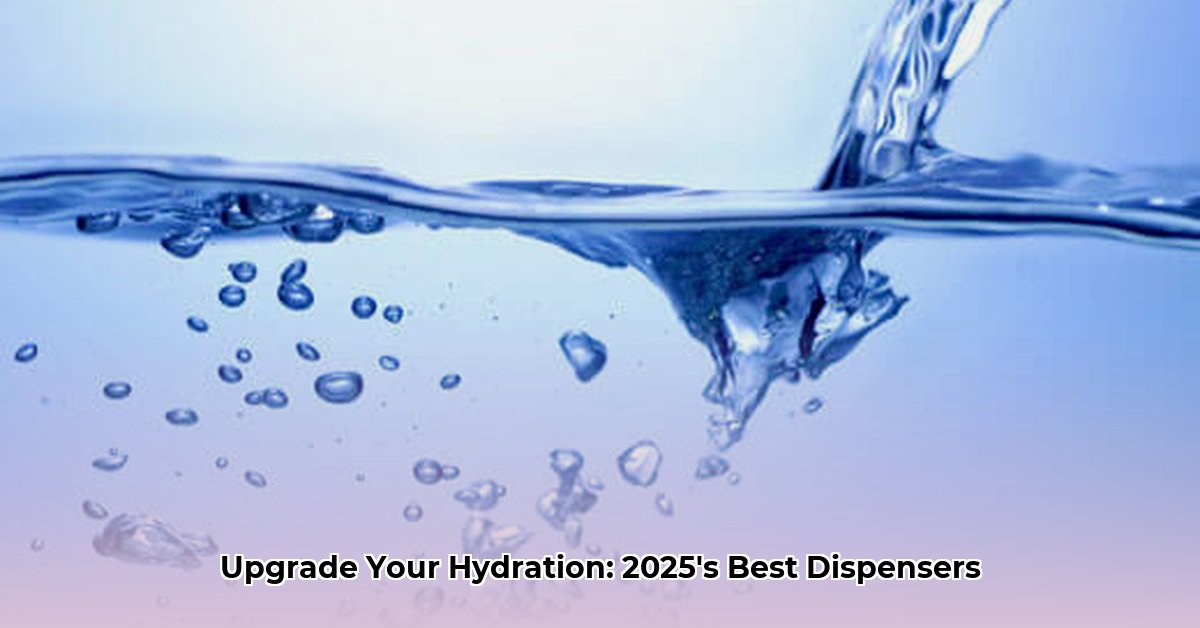Picking the right water cooler with an ice maker can be tricky! There are tons of choices out there, each with its own set of features. This guide will walk you through everything you need to know to find the perfect one for your needs. Whether you want a fancy bottleless system or a simpler bottled one, we’ll help you figure out which features matter most and which ones you can skip. We’ll cover how much ice and water you’ll need, how much space you have, and what your budget is – all the stuff that makes finding the right cooler a breeze.
Water and Ice Dispenser: Your 2025 Buyer’s Guide
Finding the perfect water and ice dispenser can feel like navigating a maze, but it doesn’t have to be! With so many options flooding the market, this guide will help you choose the best fit for your home or office while considering water filtration systems and ice maker capacity. We’ll break down the key features, walk you through the decision-making process, and even offer a peek at some top models. Let’s dive in!
Understanding Your Needs: Home vs. Office
The best water and ice dispenser for a small home will likely differ significantly from what’s optimal for a bustling office environment. At home, space might be a premium, and daily ice demand might be lower. In an office, high-capacity ice production, robust filtration, and ease of maintenance are key considerations. Understanding these distinct needs is the first step in making the right choice.
Key Features: Decoding the Dispenser
Before you even start browsing, understanding the key features is vital. These features directly impact your daily experience and long-term costs, allowing you to choose between a bottleless water dispenser and a bottled water cooler.
1. Ice Production Capacity: Chill Out and Calculate
How much ice do you really need? A small family might be perfectly happy with a dispenser producing around 24 pounds of ice daily. A larger family, a busy office, or those who frequently entertain might need a model capable of producing double that – or even more! Think about your daily ice consumption realistically to determine the needed ice production capacity. Consider peak usage times, like parties or hot summer days, when estimating your needs. Some high-end models can produce up to 100 pounds of ice per day, while compact countertop units might only manage 10-15 pounds.
2. Ice Type: Cubes, Nuggets, or Crescent?
Beyond just quantity, consider the type of ice you prefer. Standard ice cubes are versatile and work well in most drinks. Nugget ice (also known as “Sonic ice”) is soft, chewable, and absorbs flavors readily, making it a favorite for many. Crescent ice is another option, offering a balance between surface area and melt resistance. The type of ice your dispenser produces can significantly impact your overall satisfaction.
3. Water Filtration: From Basic to Best
Water filtration systems range from simple carbon filters, which primarily remove chlorine and sediment, to advanced reverse osmosis (RO) systems. RO systems provide the purest water, removing a wider range of contaminants, but they are usually more expensive and slower than carbon filters. Consider your water’s quality and your budget when evaluating water filtration options. Some experts believe that even basic filtration significantly enhances taste and reduces impurities. Look for certifications from organizations like NSF International to ensure the filter’s performance is verified. Multi-stage filtration systems, combining sediment filters, carbon filters, and UV sterilization, offer a comprehensive approach to water purification.
4. Water Source: Plumbing or Bottles?
This is a big decision. Bottleless (plumbed-in) systems are directly connected to your water supply, offering endless convenience, providing continuous water supply. But they require professional installation and a dedicated water line. Bottled water dispensers offer simplicity: you just replace the bottles as needed. However, you’ll face ongoing costs and the environmental impact of plastic bottle disposal. The best choice depends on your priorities. Some people prioritize convenience while others prioritize cost-effectiveness and environmental sustainability. Consider the accessibility of a water line and the cost of installation when making your decision.
5. Dispensing Options: Touchless vs. Traditional
In today’s world, hygiene is more important than ever. Touchless dispensers use sensors to detect your hand or cup, minimizing contact and reducing the spread of germs. Traditional push-button or lever-style dispensers are still common, but they require regular cleaning to maintain hygiene. Consider the user base (e.g., a public office vs. a private home) when deciding on the best dispensing method.
6. Self-Cleaning: Hygienic Happiness
Many modern dispensers include self-cleaning features such as UV sterilization or ozone cleaning. These automated systems help maintain the hygiene of your dispenser, minimizing the need for manual cleaning and ensuring optimal hygiene. Imagine it as a built-in dishwasher for your water – keeping things fresh and clean with minimal effort. This feature is increasingly important to many consumers concerned with water purity and long-term maintenance. Look for models with programmable cleaning cycles for maximum convenience.
7. Energy Efficiency: Saving Money and the Planet
Energy-efficient models can save you money on your electricity bills over time. Look for energy ratings and compare models to find the most economical option. This is crucial for the long-term viability and cost-effectiveness of your dispenser purchase, offering lower energy consumption. Furthermore, contributing to energy conservation is a growing concern for many modern consumers. There’s ongoing research into even more efficient designs, so keep your eye out for developments in this area. Look for the Energy Star certification for guaranteed energy savings.
Your Step-by-Step Guide to the Perfect Dispenser
Choosing your perfect dispenser is easier than you think with this water dispenser buying guide. Follow these simple steps:
Step 1: Assess Your Needs:
- Household Size: How many people will be using the dispenser regularly?
- Daily Consumption: How much water and ice do you anticipate using daily? Be realistic!
- Lifestyle: Do you frequently entertain guests? Do you prefer ice in your drinks all day?
- Water Quality: Are you concerned about impurities in your tap water?
- Space Constraints: How much physical space do you have available for the dispenser?
- Installation Requirements: Are you comfortable with plumbing modifications, or do you prefer a simpler setup?
Step 2: Set Your Budget:
Water and ice dispensers come in a vast range of prices. Set a realistic budget before you start shopping to avoid disappointments, allowing you to determine best water dispenser within budget. Remember to factor in potential installation costs if opting for a plumbed-in model. Don’t forget to account for ongoing costs like filter replacements or bottled water refills.
Step 3: Measure Your Space:
Carefully measure the available space where you plan to install the dispenser. This ensures a proper fit and avoids potential issues later. Check the dimensions of the models you’re considering, assessing the space requirements. Consider both the width, depth, and height of the dispenser, as well as any necessary clearance for ventilation or bottle changes.
Step 4: Decide on Your Water Source:
Will you go for the convenience of a plumbed-in system or the simplicity and portability of a bottled system? Think about installation requirements and long-term maintenance when considering the water source options. Consider the aesthetic impact as well; bottleless systems generally look cleaner and more modern.
Step 5: Select Your Desired Filtration:
Based on your water quality concerns and budget, choose the appropriate filtration level. Carbon filters offer a more basic solution while Reverse Osmosis provides advanced purification, ensuring optimal water purity. Research the specific contaminants you’re concerned about in your local water supply to make an informed decision.
Step 6: Compare Models:
Now it’s time to compare different models based on your needs and preferences. Look at features, price, and reviews. Don’t solely focus on price; consider all aspects and compare different dispenser models. Read reviews from multiple sources to get a balanced perspective on each model’s performance and reliability.
Top Models: A Glimpse at the Market
While we can’t provide an exhaustive review, here are some examples illustrating the range of options:
| Model | Water Source | Ice Production (lbs/day) | Filtration Type | Notable Features | Approximate Price Range (USD) | Recommended For |
|---|---|---|---|---|---|---|
| Example Model A | Bottled | 24 | Carbon | Easy bottle changes, compact design | $200 – $300 | Small households, limited space |
| Example Model B | Plumbed-in | 48 | Reverse Osmosis | UV sterilization, large capacity, touchless dispensing | $800 – $1200 | Offices, larger families |
| Example Model C | Bottled | 36 | Carbon/Activated Carbon | Sleek Design, Child Lock, multi-temperature settings | $350 – $500 | Families with children |
| Example Model D | Plumbed-in | 70 | Reverse Osmosis + UV | High capacity, nugget ice, advanced filtration | $1500 – $2000 | Large offices, heavy usage |
*Note:
- How to Stop Apps From Running in the Background to Boost Your - December 1, 2025
- How To Move Apps On Your Droid For Better Organization - November 30, 2025
- How to Move Apps on Android for Better Organization - November 29, 2025










